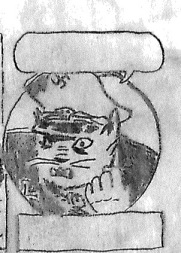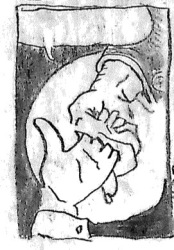Spiegelman attempts to keep the audience engaged with his work by implementing camera angle shifts, as well as variety in panel structure.
When placing the panel styles for both pages side-by-side, it may seem like they are pages from two different authors’ styles altogether. Both of these pages are critically designed to keep the audience engaged, while telling Vladek’s story in a lucid manner. When looking at the page from Maus I, it is clear that the story involves the soldier walking up and instructing the Jews to empty their pockets while getting aggressively suspicious at Vladek for carrying a large sum of money. The audience in this case engages with the story well without having to connect the dots or read too deep into the page.
However, the Maus II page stands in contrast to this structure. The panel structure shows 9 vaguely-oriented panels in front of a map of Auschwitz as a backdrop. This structure requires the audience to view the page as a whole before delving into the individual panels, in order to understand the plot. One thing that is immediately noticeable, is the continuous camera angle shifts. This shift creates a conversation-like feel, allowing the audiences to ‘follow’ the conversation between Art and Vladek, while also reading into the map of Auschwitz.

In the Maus I page, Spiegelman also employs hidden images in order to draw in the audience. Although the panel structure is the same, we see the shape of the upper-right and bottom-left panels to be more circular than the traditional rectangle employed. When noting the way in which the upper-right and bottom-left panels play out, we see a continued image of the soldier grabbing Vladek’s hand.  However, this is also a play on imagery where it can be seen that the soldier is grabbing the audience’s hand in order to put them in Vladek’s shoes. In order to draw the audience’s attention to this fact, we see that Spiegelman, yet again, employs a change in panel formation, and deliberate ‘re-shaping’ of the panel to draw contrasts between the plot line and these subtle elements. However, what is remarkable is the fact that these subtle aspects do not hinder the flow of the plot, whereas complement it and enhance the transitional flow the Spiegelman already establishes.
However, this is also a play on imagery where it can be seen that the soldier is grabbing the audience’s hand in order to put them in Vladek’s shoes. In order to draw the audience’s attention to this fact, we see that Spiegelman, yet again, employs a change in panel formation, and deliberate ‘re-shaping’ of the panel to draw contrasts between the plot line and these subtle elements. However, what is remarkable is the fact that these subtle aspects do not hinder the flow of the plot, whereas complement it and enhance the transitional flow the Spiegelman already establishes.
The close up shots towards the end of the Maus II page, also works in this manner, as it allows the audience to connect with Vladek and ‘feel’ his emotion as attention is directed towards Vladek’s face. We see that Spiegelman uses this subtle ‘attention-grabber’ not to hinder the illustration of the camp, but complement it using the emotional touch that Vladek provides. In this way, a contrast in the panel structure, as well as continuous shifts of camera angle work to engage the audience.

In this way, by altering the flow of the panels, as well as changing camera angles, Spiegelman keeps the audience engaged with the literature.
Read more about Maus and its rhetorical elements here.
